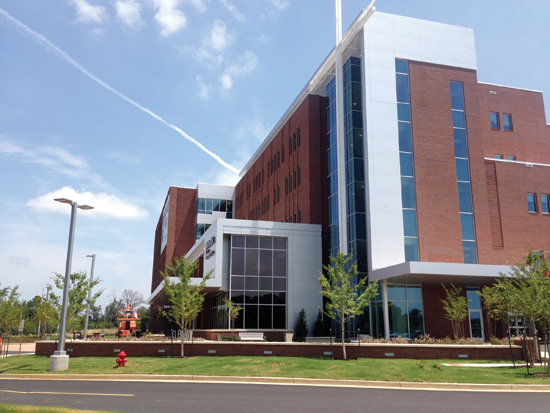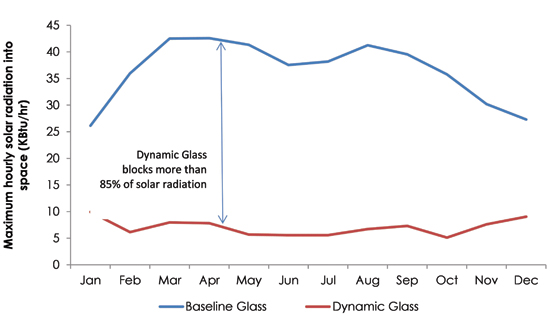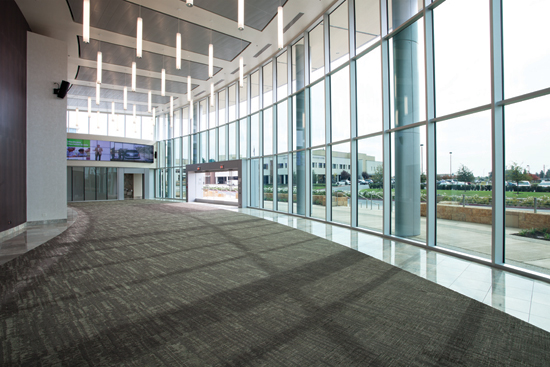The Move to Dynamic Glass
Building Occupants
In addition to improved daylighting and thermal comfort, dynamic glass allows occupants unobstructed views even in the tinted state, a key to a host of benefits. Dynamic glass is consistent with biophilic design, which seeks to connect humans with the natural environment. The premise is based on the philosophy of biophilia, the apparent instinctive preference humans have for natural geometries, forms, and characteristics within our environments. Studies have shown repeatedly that when access to natural environments is present, even through views, human beings tend to feel calmer, more at ease, more comfortable, less stressed—and their performance, sense of well-being, and even health can improve. Biophilic design is helping to improve productivity in offices, higher scores in schools, and better patient outcomes in hospitals, all with significant fiscal implications. Terrapin Bright Green, an environmental consulting and strategic planning firm committed to improving the human environment through high performance development, policy, and related research, put out a report, The Economics of Biophilia, which is a compilation of studies on the impacts of biophilic design. The report states, “The numbers and percentages presented reflect powerful evidence that many traditional design strategies that ignore nature can lead to negative impacts on human health, child development, community safety, and worker satisfaction. These effects translate directly to increased profits.”
The advantages of biophilic design are evident in all types of buildings. In offices, abundant natural light and expansive views are known to enhance both creativity and productivity. Daylight elevates the spirit and fosters innovative thinking. Large open areas with abundant natural light invite creative collaboration and teamwork among colleagues, all of which seem to make people happier, more optimistic, and get better results. Elzeyadi's study at the University of Oregon, for example, found that 10 percent of employee absences could be attributed to architectural elements that did not connect with nature, and that a person's view was the primary predictor of absenteeism. A 2003 Heschong study found that seating arrangements at the Sacramento Municipal Utility District call center influenced worker performance results. Employees with views of vegetation through large windows handled far more calls per hour than employees with no view of the outdoors.
 |
Methodist Olive Branch Hospital in Mississippi Photo courtesy of View Inc. |
Hospitals, too, are using biophilic design to improve patient outcomes. Hospital designers, administration, and staff recognize the benefits of large windows, natural daylight, and expansive outdoor views in speeding recovery. In a groundbreaking 1984 study Ulrich found that patients with a view to nature rather than a mere wall experienced hospital stays that were 8.5 percent shorter, with fewer negative observational comments from nurses, and significantly fewer strong, post-surgical analgesics, according to Terrapin, which states that later reports confirm those findings and demonstrate that “poor design and lack of exposure to nature inhibit recovery rates and blood pressure stabilization, exacerbate anxiety, and increase administration of pain medications.”
Educational facilities too are looking to biophilic solutions to help improve student achievement and reduce operating costs. According to Daylighting in Schools, An Investigation into the Relationship Between Daylighting and Human Performance by the Heschong Mahone Group, the connection between nature and performance is real. Among the group's findings:
• Classrooms with more daylighting are 20 percent faster in math and 26 percent faster in reading.
• Classrooms with larger windows are 15 percent faster in math and 23 percent faster in reading.
• Classrooms with controllable skylights show a 19 to 20 percent improvement in student performance.
• An ample and pleasant view out of a window supports better outcomes of student learning.
• Sources of glare and direct sun penetration into classrooms negatively impact student learning.
• Teachers who can control glare through windows experience improved student performance.
Nearly 20 separate studies have agreed that good daylighting “improves tests scores, reduces off-task behavior, and plays a significant role in the achievement of students” (Kats, 2006). Research also supports the notion that integrating biophilic design into the nation's school system would improve the experience of hundreds of thousands of children, an outcome that may increase the rate of retention, which in itself has implications for the U.S. economy. Some educational facilities have taken that type of thinking to the next level. There is a movement, particularly at the university level, to incorporate biophilic design in order to attract students and professors who are interested in progressive, energy-efficient facilities that lead in environmental consciousness, in reducing carbon footprint, meeting sustainability objectives, and setting an example for the broader community.
Dynamic Glass and Prevailing Standards and Codes
Dynamic glass is being increasingly referenced in the energy codes as distinct from static glass, with California Title 24, the country's most progressive code, taking the lead. Dynamic glass is recognized in Section 140.3 of that code, and also by the 2012 edition of the International Energy Conservation Code (IECC), ASHRAE 90.1 – 2013, the 2015 edition of the International Code Council (ICC) building code, and even the upcoming Energy Star for Windows criteria. As these regulatory agencies update their codes and standards to fully recognize dynamic glazing, architects can use the performance path for dynamic glass to demonstrate lower energy use than the baseline model and exceed code requirements.
LEED v4 has several changes that are impacted by the use of intelligent dynamic glass. There is now a credit category for Integrative Design, which means the consideration of several design scenarios (including alternate façade materials and systems) to get the most efficient total building package. Dynamic glass is an enabling technology in this regard as it impacts multiple systems, providing energy and performance benefits to each. An integrative design approach will uncover these benefits early in the process. This category awards one credit for performing early-stage analysis of energy- and water-related systems.
Second, a major change in LEED v4 is that it now focuses on materials, their material toxicity (termed material transparency) and their total life-cycle impact. Products with a Health Product Declaration that discloses material make up, like some dynamic glass, will earn LEED credits. In addition, the ongoing energy benefits of dynamic glass will reduce the total carbon footprint of a building. Third, LEED v4 is focused on human centered design and performance, taking a serious, increased focus on human health that goes beyond any other building rating system. As the USGBC puts it, “Every story about a green building is a story about people.” This relates directly to the value proposition of dynamic glass and its salutary potential for occupants of all types of buildings.
| Crown Opera House Sees Savings in Dynamic Glass | ||
The historic Crown Opera House in New Bremen, Ohio, built in 1895 is undergoing a restoration project that contains high glazing areas. An analysis was conducted to compare dynamic glass versus a baseline glazing package of dual-pane low-e glass with internal motorized shades and exterior sun shades. Dynamic glass was found to reduce peak load cooling by more than 20 percent. HVAC systems are sized by the peak cooling load requirement (cooling needed during the hottest time of the year). By tinting the dynamic glass to 4 percent, the peak load can be reduced allowing for a smaller overall HVAC system. The dynamic glass blocks more than 85 percent of unwanted solar radiation compared to low-E glass, as it automatically adjusts the tint level to block unwanted solar radiation entering the space. The accompanying figure shows the maximum hourly solar radiation entering the space (west facing offices) for the dynamic glass and the baseline glass. With the dynamic glass, the Crown Opera House will realize substantial first time cost savings and annual operating savings with a payback period of 3 years.
|
| Meeting California Title 24 Requirements | ||
At California’s Clovis Community Health Center the challenge was to utilize a large glass façade around the center’s foyer that would create a high-technology, state-of-the-art design that meets California’s Title 24 Energy Code. Henderson Architectural Group designed a separate stand-alone building to be the hospital’s eye-stopping showpiece at the front of the hospital’s campus. Some 5,072 square feet of dynamic glass, primarily 5 foot by 10 foot panels, was installed to control solar heat gain around the front entrance of the center, while fulfilling code requirements. The installation met the façade design specifications while matching the high-technology, high-touch design goals with an automated dynamic windows to control daylighting and glare. The glass provides uninterrupted views to the outdoors and a stunning building design at the entrance of the campus.
|
Dynamic Glass: A Promising Future
Dynamic glass has significant potential in the emerging world of high-performance green buildings. It not only provides the best energy performance for the building during operation, but also reduces capital cost and material waste in construction while improving occupant comfort and productivity. In addition to allowing greater design freedom to the architectural community, dynamic glass has the potential to positively affect worker productivity through improved thermal and visual comfort as well as connection to the outdoors. Materials such as external and internal shading devices used in the construction or retrofit of buildings can be reduced or eliminated and HVAC equipment and systems downsized. In addition, by limiting heat gain in summer and allowing it in winter, overall energy consumption and associated costs can be decreased. With these advantages, designers and building owners are seeing a clear path to increased specification of dynamic glass.
 |
View Inc. is the pioneer in large-scale architectural dynamic glass that intelligently tints and clears in response to external conditions and user preferences, enabling unparalleled control over the amount of light and heat entering a building. www.viewglass.com |










